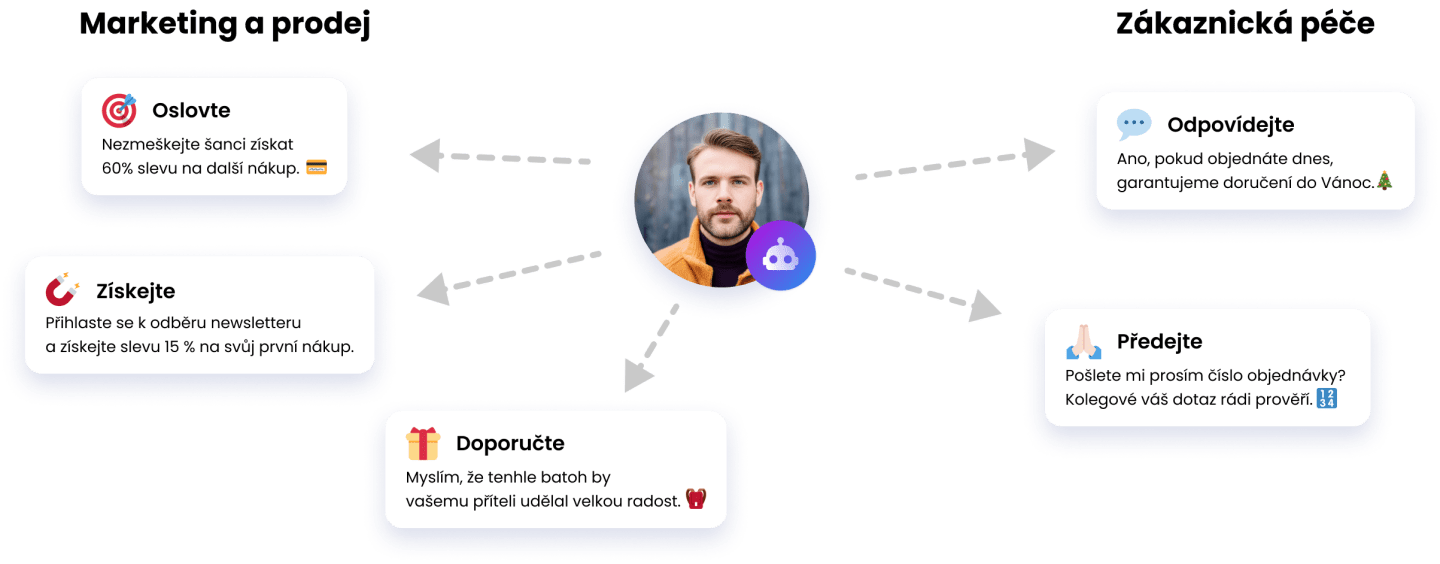Poznejte Smartsupp Mira, nového AI nákupního asistenta
Smartsupp Mira: Personalizované AI pro online nákupy
Smartsupp Mira promění váš zákaznický servis k lepšímu. Je k dispozici 24 hodin denně, samostatně vyřeší většinu dotazů návštěvníků a pomůže jim s výběrem produktů i dokončením nákupu. Zvyšte tržby svého e-shopu díky AI.
na základě více než 700 recenzí na

Smartsupp Mira AI není jen virtuální asistent, je…



Důvěřuje nám přes 100 000 zákazníků po celém světě




























Jak může vypadat váš AI nákupní asistent




AI nákupní asistent: všestranný nástroj, který vám zjednoduší každodenní úkoly

Aktivně oslovuje
AI nákupní asistent zaujme návštěvníky vřelou a zajímavou konverzací. Automaticky zodpoví nejčastější dotazy a doporučí vhodné produkty.
Nasměruje váhající návštěvníky
Sledujte v přímém přenosu, jak se z návštěvníků webu stávají zákazníci. Ani se nenadějí a z fáze „jen se dívám“ se ocitnou ve fázi „to musím mít!“
Spojí zákazníky s operátory
Když návštěvník webu řeší složitější problém, AI nákupní asistent Mira předá konverzaci zkušenému operátorovi živého chatu.
Získejte vlastní AI jednoduše na pár kliknutí!
Pro vytrénování vašeho AI nákupního asistenta a vytvoření jeho unikátní tonality potřebujeme projít data na vašem webu – nebo můžete nahrát potřebné soubory do naší databáze. Pak už stačí chatbota otestovat a může jít do ostrého provozu!

Požádat o schůzku
AI Smartsupp Mira: Nejčastější dotazy
Existují dva způsoby, jak AI nákupního asistenta „vytrénovat“. V prvním případě Smartsupp Mira zanalyzuje data na vašem webu – na základě toho zjistí, jak se svými zákazníky komunikujete. Druhý způsob je, že potřebná data nahrajete ručně z produktového katalogu – poradíme si s celou řadou formátů, takže můžete zvolit ten, se kterým se vám pracuje nejlépe. Následně vytvoříme vašeho unikátního AI nákupního asistenta, který bude vaše zákazníky provádět nákupním procesem a bude s nimi hovořit tak, jak si budete přát.
Jednoduše řečeno – z takových, které jí dodáte. Pokud ji necháte projít váš web, bude čerpat informace přímo z něj. Nebo může získávat informace z produktového katalogu, který nahrajete. Nad tím, odkud Mira získává data, máte plnou kontrolu. 💪🏻
Chatboti s umělou inteligencí obratem zodpoví dotazy vašich návštěvníků a zvládnou vyřešit jednoduché problémy. AI nákupní asistent však kromě toho rozumí i vaší obchodní a komunikační strategii – poskytne proto zákazníkům přesnější a více personalizovanou podporu. Mít na webu AI nákupního asistenta je podobné, jako mít v kamenném obchodě přátelského a ochotného prodavače. Smartsupp Mira provází zákazníky nákupem od návštěvy webu až po dokončení objednávky. Dostávají tak stejnou pozornost, kterou očekávají ve fyzické prodejně – a to vše z pohodlí domova.
Samozřejmě, bezpečnost je naší hlavní prioritou. AI nákupní asistent šetrně spolupracuje s vaším webem a má přístup pouze k informacím, které se rozhodnete sdílet, jako jsou informace o produktech a dotazech zákazníků. Všechna data jsou bezpečně uložena v databázi Smartsupp, kde využíváme nejmodernější bezpečnostní technologie, abychom je ochránili. Máte plnou kontrolu nad tím, co AI nákupní asistent uvidí – informace bude hledat jen tam, kde mu to dovolíte. V každém případě pro něj vždy bude na prvním místě stoprocentní bezpečí vašich dat.
Ano, Smartsupp Mira používající klienti Smartsupp po celém světě, proto se dokáže bez problému přizpůsobit jazyku vašich zákazníků.